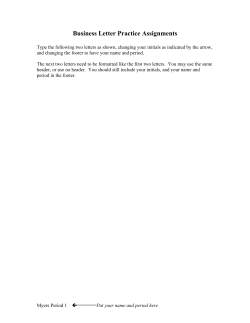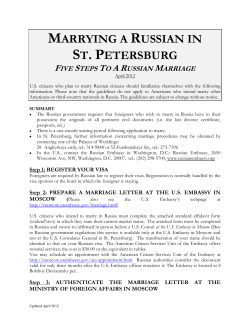
Russian Keyboard Label Instructions and Specifications Smart Keyboard Solutions
Smart Keyboard Solutions
1855 E Southern Avenue, Suite #213
Mesa, AZ 85204
Phone: 877-477-1988
Visit our web site at:
SmartKeyboardSolutions.com
Buy this product online
Russian Keyboard Label
Instructions and Specifications
Table of Contents
Clear Russian Labels - Product Description
Opaque Russian Labels – Product Description
Compatibility
Configuring Windows 8 for Russian
Configuring Windows 7 and Vista for Russian
Configuring Windows XP for Russian
Configuring Microsoft Office for Russian
Installing the Labels
How to Install the Labels
How to Use the Russian Layout in Windows 8
How to Use the Russian Layout in Windows 7, Vista, and XP
How to Type Russian Characters
Product Features
Clear Russian Keyboard Labels
Clear Russian Labels Description. The Russian keyboard labels are clear labels with Russian
characters on the lower right corner or the right side. This allows you to convert any keyboard to
a bilingual Russian keyboard. The labels are available in green (for light or beige colored
keyboards) and white (for black keyboards).
1
Opaque Russian Keyboard Labels
Opaque Russian Labels Description. The opaque Russian keyboard labels are opaque black
labels with white English US characters on the left and green Russian characters on the right side
of the labels. This allows you to convert any keyboard to a bilingual English and Russian
keyboard.
Compatibility
Language Compatibility. The Russian keyboard labels are compatible with the Windows
keyboard use in the Russia, Tatar, and Yakut.
Windows Compatibility. The Russian keyboard labels are compatible with the Russian
keyboard layout in Windows 8, 7, Vista, and XP. The labels might be compatible with other
versions of Windows, but they have not been tested to ensure complete compatibility.
Configuring Windows 8 for Russian
Instructions for a Touch Screen Windows 8.x
1. Swipe right to left on the screen and tap the Settings item.
2. Tap the Change PC settings item.
3. Tap or click on the Time and language item.
4. Tap or click the Region and language item.
5. Tap or click the Add a language item in the selector.
6. Scroll through the alphabetical list of languages until you find the Russian language.
7. Tap or click on the Russian language box.
Instructions for Non-Touch Screen Windows 8.x
1. Open the Control Panel by clicking on the File Explorer button in the lower left corner of the
desktop. Click on the Desktop item under the Favorites section. Double click on the Control
Panel icon to open the Control Panel.
2. Click on the Add a language item under the Clock, Language, and Region section.
3. Click on the Add a language item.
2
4.
5.
6.
7.
Languages are listed alphabetically. Scroll to the R section for Russian.
Click on the box for Russian.
Click the Add button to return to the installed language list window.
Close the Control Panel.
Configuring Windows 7 and Vista for Russian
1. Click on the Start button in the lower left corner of the computer screen.
2. Click on the Control Panel item.
3. Select the Clock, Language, and Region option.
4. Select the Regional and Language Option.
5. Click on the Keyboards and Languages Tab.
6. Click on the Change Keyboards button.
7. Click the Add button.
8. Find the Russian country item you wish to use.
9. Click on the plus sign ("+") to the left of the Russian entry.
10. Click on the plus sign ("+") to the left of the keyboard.
11. Click on the box to the left of the keyboard layout, Russian
12. Click the OK button to select the keyboard layout and close the Add Input Language dialog
box.
13. Click on the Apply button in the lower right corner of the Text Services and Input Languages
dialog box.
14. Click on the OK button in the lower right corner of the Text Services and Input Languages
dialog box.
Configuring Windows XP for Russian
1.
2.
3.
4.
5.
6.
7.
8.
Click on the Start button in the lower left corner of the computer screen.
Click on the Control Panel item.
Click the Date, Time, Language, and Regional option.
Click the Other Languages option.
Make sure that you are viewing the Languages tab.
Click on the Details button.
In the Text Services and Input Languages dialog box, click on the Add button.
Scroll through the list of languages until you see the language and country you want. Note
that many languages have multiple countries which may be different keyboard layouts. Make
sure that the language and layout you select matches that of your language labels.
9. Click on the OK button to setup the language and close the language selector box.
10. Click the Apply button in the lower right corner of the Text Services and Input Languages
dialog box.
11. Click the OK button to complete the language setup.
12. Click OK to close all other dialog boxes that may be open.
13. Close the Control Panel.
3
Configuring Microsoft Office for Russian
If you are using Microsoft Office, you may need to configure it for the Russian keyboard.
1.
2.
3.
4.
5.
Begin by locating and selecting the Microsoft
Office Tools in the main program menu.
Microsoft Office Language Settings
If you are prompted for the Office installation
disc, insert it and answer the prompts.
In the Enabled Languages dialog box, click the
boxes to the left of the languages you wish to
use in Microsoft Office.
When you have finished selecting the
languages, click the Apply button.
Click the OK button to close the Enabled
Languages dialog box.
Installing the Labels
The language labels are arranged on a selfadhesive, die-cut sheet with six labels in each row.
The labels are printed in the order of the keys of a
standard keyboard. For example, whether you are
using an English or a German keyboard, you start
applying the labels at the upper left key and
continue applying the labels to the right. There are
certain exceptions to the layout depending upon the
keyboard. For example, on some keyboards the "\"
key appears on the second row from the top while
others might place it on the third row from the top.
You can use the illustration at the beginning of this
document as a guide to placing the labels. (If you
are using an US English keyboard, you can use the guide letters that appear under each keyboard
label in the set.)
Turn off the computer before you install the keyboard labels. It is not necessary to unplug the
keyboard. If you are installing the labels on a desktop keyboard, check to ensure that the fold-out
feet on the underside that hold the keyboard at an angle are folded in so they do not get broken
when you are placing the labels.
Before you begin installing the labels, you should clean the tops of the keyboard keys with a
mild cleanser, such as a diluted detergent and water. Test the cleanser on one key to make sure
that it does not damage the key surface or the printing. Be careful to prevent any cleanser liquid
from dripping down under the key into the key mechanism.
You should check the Windows keyboard layout (or your language software) before you install
the labels. You can do this by configuring Windows for the language and then pressing each key
on the keyboard to ensure that it matches the layout of the language labels (this is especially
4
important for those language labels that include optional labels). When you are sure that the
labels match the Windows keyboard layout, you can start installing the labels.
The easiest method to install the labels is to insert a a small knife blade under the corner of the
label and gently lift it from the sheet. Place the label gently on the correct keyboard key making
sure that it is centered and properly aligned. When you have the label properly placed, press it
down while removing the knife blade. When you are satisfied that the label is straight and on the
correct key, use a rounded object, such as the the rounded end of a plastic pen, to burnish (i.e.,
rub) the label firmly in place.
Note: once you place the keyboard label and burnish it in place, it cannot be moved to
another key.
How to Use the Keyboard Layout in Windows 8
Instructions for a Touch Screen Windows 8.x
You must add the language keyboard to your Windows system before you can select the
keyboard to use.
1. Tap or click on the keyboard icon in the taskbar.
2. When the virtual keyboard opens, click on the keyboard selector in the lower right corner of
the virtual keyboard.
3. Select the Russian language from the list of language keyboards installed.
4. The virtual keyboard will display the Russian language layout. You can use the virtual
keyboard to type in Russian or click on the "X" box to close the virtual keyboard and type in
the hardware keyboard.
Instructions for a Non-Touch Screen Windows 8.x
1. Click on the Language selector in the lower right corner of the Taskbar. If the keyboard is in
English, the selector will say ENG; if the selector is in Russian, it will say PYC.
2. Select Russian to switch to the Russian keyboard layout.
How to Use the Russian Keyboard Layout
After you setup the Russian keyboard in Windows, you can easily switch between Russian and
the system language (i.e., the language of Windows in your computer). You switch languages
using the keyboard selector located in the Task Bar at the bottom of the computer screen.
1. When you setup the Russian keyboard, you will see a language indicator on the Task Bar to
the right near the System Tray
(see the red arrow in the picture).
For example, if you are typing in
English, the language indicator is "EN." If you are typing in Russian, the language indicator
will be "RU."
2. Open the application in which you wish to type.
3. Click inside the application. For example, if you wish to type in Microsoft Word, open the
Word and click inside the text edit area.
4. Left click on the language selector box to open the keyboard menu.
5. Click on the desired keyboard layout in the keyboard menu.
5
6. After you have selected the desired language, you can start typing in the selected keyboard
language.
7. If you wish to return to the system language, click on the language selector box and select the
desired keyboard.
How to Type Russian Characters
There are no special instructions for typing in Russian in Windows. If the text entry is not
correct, you should contact your software manufacturer tech support.
Product Features
The Russian keyboard labels are manufactured of highly durable Lexan® for high quality
and long-lasting use.
The Russian letters appear on the right side of the clear label allowing you to create a
bilingual keyboard.
Select the Russian letter color, green or white, to best suit your keyboard color. We
recommend green letters for beige and light colored keyboards and white letters for black
or dark colored keyboards.
The letters are printed on the underside of the label making it almost impossible to
scratch or wear off.
The labels are self-adhesive for peel-and-stick installation.
The adhesive will not harm the original printing on the keyboard keys.
If desired, the labels may be removed without damaging the keyboard.
The Russian labels are designed to fit standard PC computer keyboards. If necessary, the
labels can be trimmed with scissors prior to installation.
6
© Copyright 2025

















